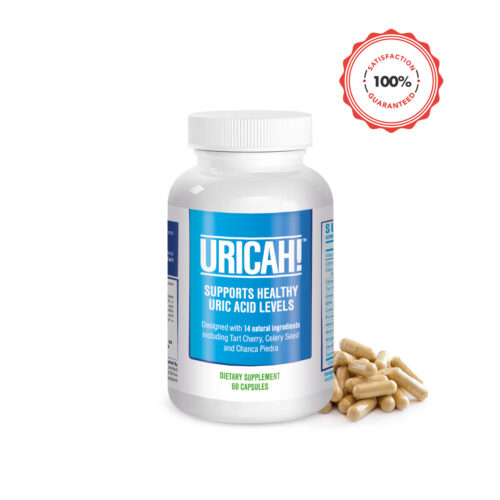Getting older brings many changes to our bodies, and one condition that becomes increasingly common with age is gout. If you’ve recently experienced sudden, intense joint pain or been diagnosed with elevated uric acid levels, understanding how age influences gout development can help you take control of your health.
Gout occurs when uric acid – a waste product from processing purines found in foods and produced by your cells – builds up in your bloodstream and forms sharp crystals in your joints. While anyone can develop gout, the condition becomes significantly more prevalent as we age, with most first-time sufferers experiencing their initial attack after age 40.
Why Gout Becomes More Common with Age
Several biological changes occur as we age that directly increase your risk of developing gout, making it one of the most age-related forms of arthritis.
EMERGENCY GOUT RELIEF PROTOCOL
7 tips you can use right now for immediate gout relief.
Your kidneys play the starring role in gout prevention by filtering excess uric acid from your blood. However, kidney function naturally declines with age, typically beginning in your thirties and continuing throughout life. This reduced efficiency means your body becomes less capable of eliminating uric acid, allowing levels to gradually rise until they reach the point where painful gout crystals can form.
For women, menopause represents a particularly significant gout risk period. Oestrogen provides natural protection against gout by helping maintain healthy uric acid levels, but as these hormones decline during menopause, many women experience their first gout attack in their fifties or sixties – often catching them completely off guard.
Age also brings a slower metabolism, which affects how efficiently your body processes and eliminates waste products like uric acid. This metabolic slowdown can contribute to the gradual uric acid accumulation that eventually triggers gout, even if your diet and lifestyle haven’t changed significantly over the years.
Your Gout Risk Across Different Life Stages
Understanding how gout risk changes throughout life can help you recognise when to be more vigilant about symptoms and prevention strategies.
Men face their highest gout risk during middle age, with most experiencing their first attack between ages 40 and 50. Unlike women, men don’t have hormonal protection against elevated uric acid, making them vulnerable earlier in life. The risk continues climbing throughout their forties and fifties, particularly for those with family history of gout or related conditions.
Women typically enjoy protection from gout until menopause, thanks to oestrogen’s beneficial effects on uric acid levels. However, post-menopausal women may find themselves dealing with their first gout attack in their sixties, often experiencing more severe symptoms than younger male sufferers due to the sudden loss of hormonal protection.
Older adults of both sexes face the highest gout risk due to multiple contributing factors including reduced kidney function, medication interactions, and the presence of other health conditions that can elevate uric acid levels. The good news is that with proper management, gout can be effectively controlled at any age.
How Other Health Conditions Complicate Gout
As we age, we’re more likely to develop health conditions that can worsen gout or make it more difficult to manage. Understanding these connections helps explain why gout often becomes more challenging to control as we get older.
Diabetes, high blood pressure, and heart disease all have documented links to increased gout risk. These conditions can affect how your kidneys process uric acid and may require medications that further complicate gout management.
Many medications commonly prescribed to older adults can inadvertently trigger gout attacks or make existing gout worse. Diuretics used for blood pressure control can reduce your kidneys’ ability to eliminate uric acid, while low-dose aspirin for heart protection can interfere with uric acid excretion.
Age-related weight gain creates additional challenges for gout sufferers. Excess weight not only increases uric acid production but also puts extra strain on your kidneys, creating a cycle where gout becomes progressively harder to manage without significant lifestyle changes.
Foods That Trigger Gout More Easily as You Age
As your body’s ability to process and eliminate uric acid declines with age, foods that may have never caused problems before can suddenly trigger painful gout attacks. Understanding these trigger foods becomes increasingly important as you get older.
Red meat varieties including beef steak, lamb roasts, pork ribs, mince, and beef sausages are high in purines and may trigger gout attacks more easily in older adults whose kidney function has declined.
Organ meats such as liver, kidneys, heart, brain, and tongue should be avoided entirely due to their extremely high purine content – these foods can trigger severe gout attacks even in small quantities.
Seafood options like sardines, anchovies, mackerel, herring, and shellfish including prawns and scallops often become problematic for gout sufferers as they age, even if previously well-tolerated.
Beer and spirits present a double threat for older gout sufferers – they not only contain purines but also interfere with your kidneys’ ability to eliminate uric acid, making gout attacks more likely and potentially more severe.
Moderately Risky Foods to Monitor
Some foods can be enjoyed occasionally but require careful portion control:
Poultry including chicken thighs, duck, and turkey contains moderate purines but remains a better choice than red meat.
Fish such as salmon, tuna, trout, and barramundi provide valuable nutrients but should be eaten in moderation.
Certain vegetables including asparagus, spinach, peas, and mushrooms contain purines but are generally well-tolerated due to their other health benefits.
Legumes like lentils, chickpeas, and beans fall into this category but offer important nutritional value.
Safe Food Choices for Every Age
Building your diet around these lower-risk options can help maintain healthy uric acid levels:
Lean proteins such as chicken breast, eggs, tofu, and lean pork provide essential nutrients without significantly raising uric acid. While chicken and pork do contain some purines, they’re considered safer choices because their lean nature and lower overall purine content make them less likely to trigger problems compared to organ meats or high-purine seafood.
White fish including snapper, flathead, whiting, and John Dory offer excellent protein with minimal purine content.
Dairy foods like milk, cheese, and yoghurt may actually help lower uric acid levels while providing calcium and protein.
Whole grains such as oats, brown rice, and wholemeal pasta support overall health without affecting uric acid.
Fresh fruits and most vegetables are naturally low in purines and provide antioxidants that support healthy ageing.
Practical Strategies for Managing Gout as You Age
Successfully preventing gout attacks and managing the condition becomes more important as you age, requiring a comprehensive approach that goes beyond avoiding trigger foods.
Hydration becomes increasingly critical for gout prevention as kidney function naturally declines. Drinking at least eight glasses of water daily helps your kidneys flush out excess uric acid more effectively, potentially preventing the crystal formation that causes painful gout attacks.
Regular exercise supports healthy kidney function and helps maintain a healthy weight – both crucial for gout management. Low-impact activities like swimming, cycling, or walking are ideal for older adults and can significantly reduce gout attack frequency and severity.
Weight management becomes more challenging with age but remains one of the most effective ways to control gout. Even modest weight loss can dramatically reduce both uric acid levels and the frequency of gout attacks.
Quality sleep often becomes more difficult as we age, but adequate rest is essential for proper metabolic function and uric acid processing. Poor sleep can increase inflammation and potentially trigger gout attacks in susceptible individuals.
Stress management through techniques like meditation, gentle yoga, or engaging hobbies becomes increasingly important, as chronic stress can worsen inflammation and potentially contribute to gout flare-ups.
Recognising Warning Signs
As you age, it’s important to recognise when elevated uric acid might be causing problems. Joint pain that comes on suddenly, particularly in the big toe, ankle, or knee, could indicate a gout attack.
Swelling, redness, and extreme tenderness in joints are classic signs that shouldn’t be ignored. Some people describe the pain as so intense that even a bedsheet touching the affected area becomes unbearable.
Recurring episodes of joint pain, even if mild, warrant medical attention to prevent long-term joint damage.
Working with Healthcare Providers
Regular check-ups become increasingly important as you age, particularly for monitoring uric acid levels and kidney function. Your doctor can track changes over time and adjust treatment approaches as needed.
Blood tests can reveal not only your current uric acid levels but also how well your kidneys are functioning, allowing for early intervention when necessary.
If you’re taking multiple medications, regular reviews ensure that drug interactions aren’t contributing to elevated uric acid levels.
Natural Support for Healthy Ageing
Many Australians find that combining lifestyle changes with natural supplements provides effective support for managing uric acid levels as they age. Uricah offers a comprehensive blend of 14 natural ingredients specifically designed to support healthy uric acid balance.
Developed by someone who experienced gout firsthand, Uricah provides a transparent approach to uric acid management with clearly labelled ingredients and no hidden formulas. With free shipping across Australia and a 90-day money-back guarantee, Uricah makes it easy to explore natural support for your uric acid health alongside the lifestyle changes that become increasingly important with age.
THIS IS YOUR URICAH MOMENT
Our 14 potent, natural ingredients support the body in lowering uric acid levels, alleviating the excruciating pain and discomfort caused by gout.
URICAH™ features powerful ingredients used over thousands of years to fight gout such as Tart Cherry, Celery Seed and Chanca Piedra.
Get back on your feet and live pain free with URICAH™.
LEARN MORE

